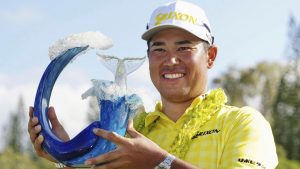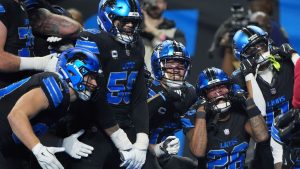Title IX stories: College coaching icons reflect on legislation’s legacy

By Laken Litman
FOX Sports Writer
Editor’s Note: This story is part of FOX Sports’ series commemorating the 50th anniversary of Title IX, which was enacted into law June 23, 1972. The series tells the stories of significant women in sports today, both celebrating the progress that has been made and recognizing the barriers that still remain.
Tara VanDerveer was finding it difficult to explain to 100 8-year-old girls at a Stanford basketball camp why she never went to basketball camp at their age.
The all-time winningest coach in women’s college basketball tried to choose her words wisely.
“When I was 8 years old, there were no basketball camps,” VanDerveer recalled telling the kids. “There were no teams to play on, no clubs to play basketball with, no junior high team or junior varsity team or freshman team or varsity team. There were no scholarships, no women’s basketball on television, no professional basketball, no Olympic basketball, no coaches.”
VanDerveer looked around the gym to see if anyone understood what she was saying. “They looked at me like I had two heads,” she said. Then one kid raised her hand and asked the million-dollar question: “Why?”
“And I’m like, I don’t really know how to explain this to 8-year-olds,” VanDerveer said. “So I go, ‘Can anyone else explain it?’”
One little girl raised her hand with an answer: “Sexism,” she said.
“And that’s clearly what it was,” VanDerveer said. “Pure sexism. No ifs, ands or buts about it.”
Women have collected stories such as this over the past 50 years since Title IX — a civil rights law that mandates gender equity and bans sex discrimination in any school or education program that receives funding from the federal government — was enacted in 1972. The stories range from the UCLA women’s gymnastics team not receiving basic nutritional supplements to North Carolina piling as many women’s soccer players as possible into one hotel room in order to play a national schedule.
Despite the shortcomings and pitfalls that remain today — like the 2021 Women’s Final Four disaster that exposed drastic inequities between the men’s and women’s tournaments — women’s sports have come far in 50 years. And while younger athletes growing up today might not fully understand Title IX, they should know the history from previous generations.
“I hope anybody who came later would have the interest and curiosity in learning about this journey that women’s sports have been on,” said Big East commissioner Val Ackerman, who was entering the eighth grade when Title IX passed. “I think that’s on the women’s sports community to make sure our history is recorded, and we’re truthful about what happened. We’re not recreating the wheel. There’s a lot to learn if you know what came before you.”
*** *** ***
VanDerveer loved basketball growing up and played all the time with the boys. In her ninth-grade yearbook, the boys’ basketball coach wrote: “To the best basketball player in the ninth grade.” The note was painful because “I couldn’t play on the team, you know?” she said.
When she played basketball at Indiana in the early 1970s, the women’s team got the gym after the men, who had it from 2-7 p.m. “Then we’d go home and have hamburger helper, and I think that’s why I’m vegetarian,” VanDerveer joked. “You never had uniforms, you laundered your own stuff, you didn’t have practice gear, you bought your own shoes, you traveled in vans, four to a room, you paid for your own meals. We flew one time to New York City for the Final Four when I was a sophomore. Then one other time when I was a junior to Manhattan, Kansas.”
Now VanDerveer makes upward of $2 million, and Stanford’s 2021 national championship game drew a record TV audience of four million viewers, more than the average NBA playoff game. She’s legendary, one of the greatest at what she does, a member of both the Naismith Memorial Basketball Hall of Fame and the Women’s Basketball Hall of Fame. She’s a five-time coach of the year.
None of those things would have been possible without Title IX.
“I really feel in some ways it has defined my life because without Title IX, I wouldn’t have a job,” VanDerveer said. “I wouldn’t be living the life I’m living. I wouldn’t have traveled all over the world. It’s basically been the thing that set the course for my life more than any other single thing.”
But when legislation passed, VanDerveer says people didn’t really know what it was, and nothing new happened right away.
“There was no, like, ‘Wow! Title IX is here! Let’s go!’ Nothing like that at all,” she said. “There were no fireworks, no band. Then a couple years later, they started having scholarships for women, and things gradually took off. But by then I was out of college.
“My timing was very poor for playing, but it was good for coaching.”
*** *** ***
There were no organized sports for girls growing up in suburban New Jersey in the 1960s, so Ackerman got her fix playing a lot of what she calls “backyard and basement stuff.” Her family had a hoop in the driveway, a badminton net in the backyard and a ping-pong table in the basement. She’d play pickup basketball with other kids in the neighborhood and throw footballs in the front yard.
“It was what it was,” she said. “You just sort of went with it and did what you could.”
Ackerman officially started playing team sports in high school — field hockey, basketball, track and field, etc. It helped that her father, Randy, was the athletics director and cared about girls’ programs.
She became one of the University of Virginia’s first female athletes to earn a scholarship in 1977, which was only seven years after the school became co-ed. The team had one full scholarship, so she shared it with a teammate. Ackerman describes the Cavaliers’ women’s basketball program back then as being in starter mode: There were no pregame meals, no air travel. The men’s team was better off, and that was reflected in crowd size. While the men played in front of sellout crowds, Ackerman doesn’t know if 100 fans came to her team’s games.
“It was never what the men had,” she said. “Not even close. That took decades.”
Conditions gradually got better. Ackerman was upgraded to a full scholarship her second year, and she became a three-time team captain and a two-time Academic All-American. She was the first 1,000-point scorer in program history. By the time she graduated, UVA had been nationally ranked, won a Christmas tournament and made it to the college postseason in the Association for Intercollegiate Athletics for Women, the predecessor league for women’s sports before the NCAA took over.
These experiences put Ackerman on a path to become one of the most important and trailblazing women in sports today. She briefly played basketball in France before earning a law degree from UCLA in 1985 and then working for the NBA as a staff attorney. She served as a special assistant to commissioner David Stern before being named the WNBA‘s first president in 1996 and was also the first female president of USA Basketball. She’s currently the commissioner of the Big East, a job she has held since 2013.
*** *** ***
In the early days of Title IX, there were places that anticipated enforcement and acted swiftly. At UCLA, chancellor Charles Young created a separate athletic department for women and hired Dr. Judy Holland as the school’s first women’s athletics director. She was given less than $300,000 to cover everything from coaches’ salaries and scholarships to uniforms, transportation and food.
Valorie Kondos Field, who was hired as an assistant women’s gymnastics coach at UCLA in the 1980s before serving as head coach from 1991 to 2019, remembers that time well. She was the only woman coach on staff. Her athletes, who were competing at the highest level and going to the Olympics, didn’t have access to meal supplements, training tables, academic tutoring, massage therapy or even cherry juice after practice.
They didn’t get those things until the ’90s. If Kondos Field, who led the program to seven national titles, wanted something, she had to fundraise.
“It was like, ‘OK, you can do this, but you need to fundraise for it,’” said Kondos Field, who is often referred to as Miss Val. “So I’d fundraise for it, we’d get it, and then it would be in our budget. Then I’d go on to the next thing. ‘You can have it, but you’ve gotta fundraise.’ Then they’d put it in the budget. Those were the steps.”
Thanks to Holland, one of the true godmothers of Title IX, UCLA women’s teams were always championed within the athletic department.
“She never made us feel like we were second-class citizens,” Kondos Field said. “They were student-athletes regardless of which gender they were. Same with the coaches. She made us feel like we were all just Bruins — not ‘Lady Bruins.’”
*** *** ***
Women’s sports at the universities of Texas and North Carolina followed similar trajectories. Chris Plonsky, the chief of staff and executive senior associate athletics director at UT, previously served as the women’s athletics director at Texas. Title IX passed when Plonsky was going into the 10th grade. She described herself as a “typical tomboy” who loved basketball and played everything from touch football to baseball with her friends in the neighborhood. She remembers wondering if someday there would be scholarships for women, like there were for men.
When she was hired to be the women’s sports information director at Texas in 1981, “my eyes almost fell out,” said Plonsky, who was coming from a media relations role at Iowa State. At that time, “a buzzsaw of a leader,” Donna Lopiano, who was hired in 1975, was the women’s athletics director.
“So I get to Texas, and they were already selling season tickets, had sports medicine and academic supervision and support in place for women’s sports,” Plonsky said. “We had a Fastbreak Club for Jody Conradt’s [basketball] program. This was donors who would pay extra money to sit in a room and have players and Jody come in after a game and break the game down for them.
“I mean, think about that era. Donna was hard-driving, always ‘if you’re not moving forward, you’re a step behind’ kind of leader.”
In 1992, women athletes sued UT, accusing the school of discrimination against women who wanted to play college varsity sports. The lawsuit hoped to force Texas to add softball, soccer, crew and gymnastics as varsity sports. At the time, the women’s department funded eight varsity sports, while there were nine men’s varsity sports. And, according to the suit, the men’s department had 304 athletes while the women’s side had 90.
The lawsuit was settled in 1993, and UT added three varsity sports in soccer, softball and crew. Plonsky recalls the additions infusing about 150 women into the department. The settlement also put athletics departments around the country on notice that they needed to address any Title IX concerns ASAP.
*** *** ***
While Anson Dorrance is synonymous with the North Carolina women’s soccer program and coached some of the greatest players of all time in Mia Hamm and Kristine Lilly, his first job at UNC was coaching the men’s program in 1976. Prior to that, Dorrance played for the Tar Heels from 1970 to ’74 but had no coaching experience. He was going to law school part-time when he got the job.
In 1979, former UNC athletics director Bill Cobey took Dorrance to watch a women’s club soccer team that had petitioned for varsity status. When Dorrance gave his opinion that the team was worthy of varsity status, Cobey offered him the opportunity to coach both the men’s and women’s teams as a full-time employee.
Dorrance, who ultimately dropped out of law school with six credits unfulfilled, coached both programs for 10 years on one budget that he split 50-50.
“I didn’t have any patriarchal opinion that men should get more,” he said. “I loved the women, which is why I selected them when I split the program. But also, I thought that was fair. You don’t have to be a social scientist or a philosopher to know that’s the right thing to do. That was the only thing to do.”
Aside from maybe the football and men’s basketball programs at the time, no other Tar Heel team was “bathing in luxuries,” Dorrance recalled. “We were all trying to make 28 sports work. I don’t think anyone had advantages over anyone else. We were just trying to survive on the budgets we were given.”
Like Kondos Field at UCLA, Dorrance had to fundraise. Right out of the gate, he wanted his team to play a national schedule, which meant traveling all over to grow the soccer narrative around the country. He’d generate income to help pay for the travel through public speaking.
“We probably could have played a regional schedule and been fine, but we were very ambitious,” Dorrance said. “So we went all over the place. Tightened our belt. Stuffed as many women as possible into [hotel] rooms to fit into our budget. But it wasn’t any different than the men’s budget — they were also stuffing players into rooms. It wasn’t like they had every luxury and we didn’t.”
Dorrance’s plan ultimately led to UNC achieving national prominence and winning a record 21 national championships — the first in 1982. In 1997, when asked if North Carolina was a football or men’s basketball school, as both teams were ranked No. 1 in the country at the time, legendary men’s basketball coach Dean Smith famously said, “This is a women’s soccer school. We’re just trying to keep up with them.”
Today, the UNC women’s soccer program has some of the finest facilities in the country. The program has close to a $6 million budget endowment, and “we no longer pile kids into rooms,” Dorrance said.
*** *** ***
VanDerveer isn’t sure her current players fully understand the significance of Title IX.
“I’d say they have a peripheral understanding,” she said. “But do they really understand? No. In a way, that’s good they don’t know how bad it was. You hope that, just like those little girls at camp, they are incredulous this could happen.”
So many things taken for granted today wouldn’t have been possible without Title IX: the WNBA, women’s sports on national television, the U.S. women’s national soccer team fighting for and ultimately achieving equal pay.
“And that’s awesome,” VanDerveer said. “I think we are going in the right direction, but it’s been 50 years. We are still dealing with sexism, like the 8-year-old camper pointed out. The stuff we had to go through at the 2021 Women’s Final Four was so disappointing and painful. Who would think that could happen in this day and age? It was sad.
“You’ve always felt maybe like we go two steps forward, one step back.”
Added Ackerman: “I’m the glass-half-full person. It’s extraordinary what’s been accomplished in the last 50 years, especially for a person like me. You’ve got a lot of people in high school and college sports, very honorable people like my dad, trying to do the right thing.
“The zeal to criticize and say it’s always been this way — no, it’s not always been this way. It’s pretty damn good right now on many fronts. I do think when there are gaps, we have to call them out. But we also have to recognize the gains.”
Laken Litman covers college football, college basketball and soccer for FOX Sports. She previously covered college football, college basketball, the U.S. Women’s National Soccer Team and the Olympics at Sports Illustrated, USA Today and The Indianapolis Star. Her first book, written in partnership with Rizzoli and Sports Illustrated and titled “Strong Like a Woman,” was published in spring 2022 marking the 50th anniversary of Title IX.






